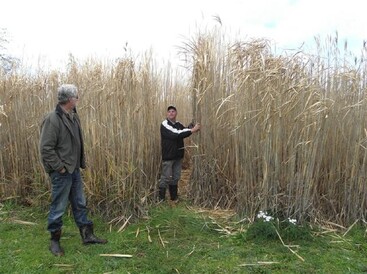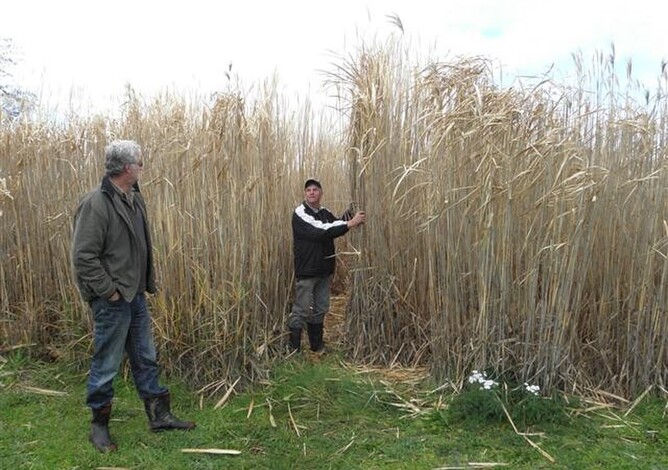June is the month that I always associate with cold damp weather which is characteristic of the National Fieldays. This year, my annual pilgrimage to the Fieldays found that although it was quite cold it was not damp and in terms of weather was quite a pleasant day. It was also different in that I was going there with the express purpose of having at least two meetings with people who had contacted me regarding serious interest in being involved in the Miscanthus industry. It made a bit of a change from most years when my objective in going has been considerably less clearly defined.
I also happened to meet with the associate minister for MPI – Jo Goodhew. She seemed pleased to have finally met somebody who initially did not know who she was. Inevitably I was asked by her private secretary how things are going with Miscanthus and when the Minister asked what Miscanthus was, I was able to dive in my bag and pull-out the latest Miscanthus New Zealand Limited (MNZ) brochure that I “just happened to have with me”.
Such opportunities come up when you least expect them and you have no idea as to whether they have been useful commercially until quite some time later. My view is that the more people who know about Miscanthus and the more people who have factual information that they can consider, the better for the Miscanthus industry.
In the past month I have had contact from a number of people wanting to purchase plants to establish trials of their own. One such person is keen on growing Miscanthus to provide cover for pheasants – as part of a commercial venture. Another is a very innovative agricultural contractor who is not only interested in finalising the development of some fascinating machinery for harvesting Miscanthus and other crops, but is also going to some effort to get significant areas of Miscanthus planted in his locality. If this is successful – and we expect it will be – it will provide him with future harvesting work. Since the Fieldays, I have spent two full days with him and if only a small proportion of his practical ideas come to fruition, they will have been very worthwhile days for both him and for MNZ.
At the same time Lincoln Ph.D. student Chris Littlejohn is doing some impressive work. He is growing Miscanthus on Canterbury farms to provide shelter from Northwest winds and is examining the ecosystem services and commercial benefits of doing so. We are taking steps right now to get his monthly reports put up on this website so that visitors can see a completely independent viewpoint on the development of Miscanthus in Canterbury. They will also see pictures of his first season Miscanthus that reached more than 1 m tall.
Somewhat to my surprise, even the Miscanthus that is being grown on an un-irrigated site is doing well, particularly when one takes into account the fact that these plants were planted quite late in the season. I am really looking forward to seeing how these develop over the coming year and everybody will obviously be interested in learning what ancillary benefits such shelter planting can produce. When the crop is harvested on these sites, I am anticipating that the resulting product of chopped up Miscanthus will be able to be used as bedding for calves on the same farm where it was grown.
That then leads into the whole area of using Miscanthus for stock bedding – something that was its original and continuing use in the UK. We have looked at the amount of animal bedding being marketed by farm merchandise companies and this market does look quite small (at present). However closer investigation with end users suggests that with the development of feed pads, and herd barns in which cows can be wintered, the market could be reasonably large while also being on a scale that can be managed with local production and supply. Over the next month MNZ will be investigating this further.
I have shown below, two photographs, taken recently of a four-year old stand of Miscanthus just off Fairfield Avenue, Huntly. The first photograph shows the variability that has occurred to some extent in this Miscanthus as a result of the intense summer drought. Some of the plants were only in the order of 2 m tall while others were at least 4 m tall.
The other photograph shown below is another part of the same site that also shows a larger than normal degree of variability but which gives a better impression of the quantity of biomass that has been produced by this crop in spite of the drought. These plants are in the process of dropping their leaves right now and it is interesting to see that while some have had completely dropped their leaves, others retain quite leafy tops. At this particular spot, the plants were planted at the spacing of 1.25 m x 1.25 m which results in a requirement for only 64% of the plants needed for normal establishment. We do not have access to the measurements from the harvest of this crop but at some stage it will be interesting to find out the impact of such wider spacing on the ongoing per hectare production levels.
As with all Miscanthus stands, the best time to harvest will depend on the balance between harvestable biomass and moisture content which tend to counteract each other as the winter progresses. Moisture content reduces as the winter progresses (May to August) while harvestable biomass is also reducing somewhat.
The innovative agricultural contractor whom I mentioned earlier is close to finalising a machine that will be able to harvest Miscanthus, or corn stover, and to turn it into pellets directly as it is being harvested. For some end uses this will be particularly helpful and will certainly make transport of the harvested material more cost efficient.



